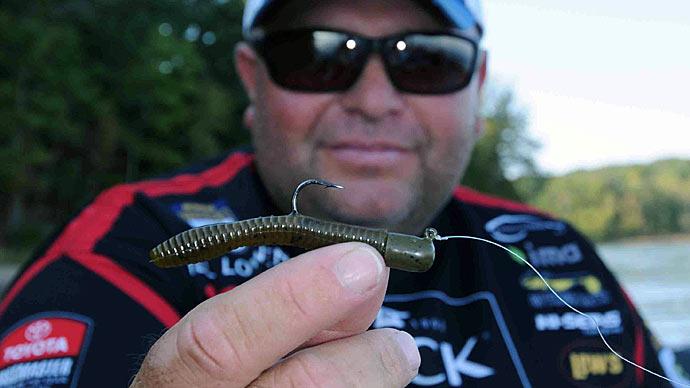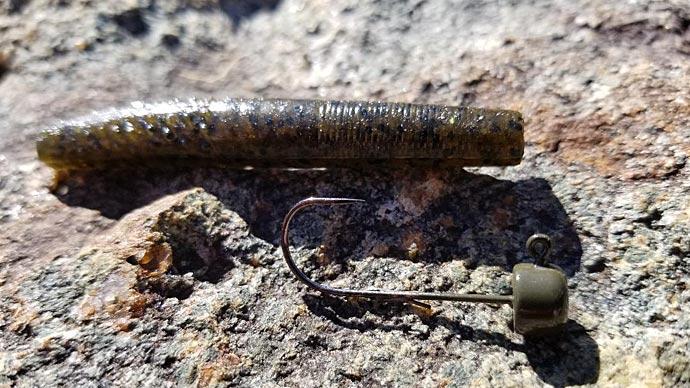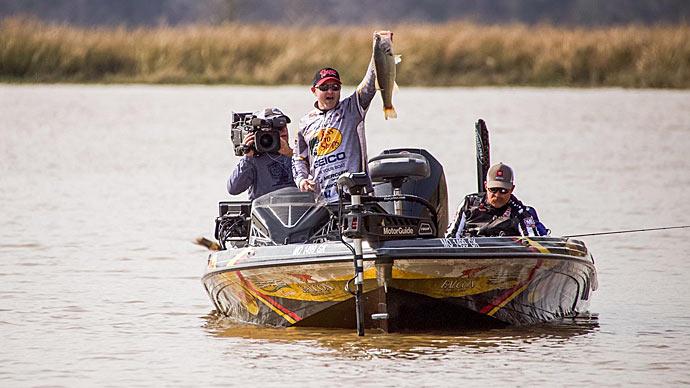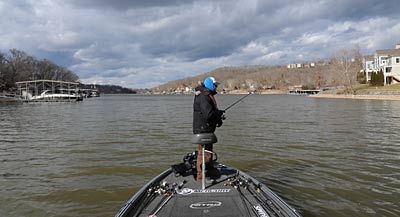
Jack Uxa decided to take a break during a tough day of fishing at Lake of the Ozarks.
The Missouri guide deployed his Minn Kota Talons, threw out his lure, and sat down to eat an apple. “A bass picked (the lure) up while it was just sitting there, and it was the biggest bass (a 3-pounder) I caught that day,” Uxa says. “I was pretty floored, so I did it a couple more times while sitting there eating my apple, and I caught a couple more fish.”
The lure Uxa dead-sticked while eating his apple was a small jig and stickworm combo known as the Ned Rig. Conceived by outdoor writer Ned Kehde of Kansas, the Ned Rig is a finesse fishing style that elicits bass strikes in even the most challenging conditions.
Uxa believes the Ned Rig has become so effective because bass have become turned off to all the “cool new baits” introduced in recent years. “For the last 15 to 20 years, fishermen have gotten much better,” Uxa says. “I think the average guy nowadays would have been a pro 20 years ago. As fishermen have evolved in education, technology, and equipment that has gotten so much better, the fish that like the Ned Rigs have done a 180 from all the new cool stuff, and that is because of pressure.”
The Ned Rig is Uxa’s pick for his guide clients when they are having trouble catching bass on other lures. “It gets a lot of bites, and it catches fish of every size,” Uxa says. “The Ned Rig works exceptionally well in rocky situations. You can throw it in vegetation areas, but it doesn’t seem to shine in places with a lot of vegetation.”
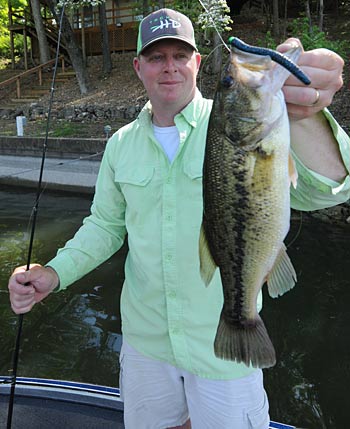
The Lake of the Ozarks guide sets up his Ned Rig with a 1/8-ounce mushroom-shaped jighead that he modifies by drilling a hole in the top of the jig and gluing a piece of 50-pound test fluorocarbon into the hole to create a weed guard. Uxa occasionally matches the jighead with small soft plastic creature baits and craws, but he prefers rigging the jighead with the buoyant plastic stickworm such as the Z-Man TRD or the Z-Man ZinkerZ. He cuts the 5-inch ZinkerZ in half to make a more compact Ned Rig. Both the TRD and ZinkerZ are made from ElazTech material which is naturally buoyant and allows the finesse worm to float off the bottom.
When fishing in clear water, Uxa selects Ned Rig worms in green hues such as green pumpkin, sprayed grass, and green pumpkin/purple flake. The Ned Rig has also produced for him in dirty water with a visibility of less than 1 foot. He opts for a black-and-blue stickworm for his rig in the off-colored water.
Spinning gear and light line are imperative when fishing the lightweight Ned Rig. Uxa throws his Ned Rig on a 6-foot, 10-inch medium light-action Abu Garcia Pro Series spinning rod combined with a Pflueger President 30 spinning reel. He avoids the hassle of tying fluorocarbon leaders on braid line by fishing the Ned Rig exclusively on 6- or 8-pound Berkley Trilene XL monofilament line.
Retrieving the Ned Rig in a variety of ways will generate strikes. “There are times where I will scrub it along the bottom, which is a steady retrieve similar to fishing with a wobble head jig,” Uxa says. “There are times I will work it along the bottom like I would a plastic worm but a little bit slower because it is lighter weight. There are also times when I will swim it back. All the retrieves are slow. I have to play around with it to see where the fish are in the water column.”
Dead-sticking the Ned Rig while eating an apple will also trigger bites from finicky bass.
The apple-eating incident proves you can never fish a Ned Rig too slow. Uxa notices that his client's biggest mistake is putting too much action on the Ned Rig. “They just fish it too fast,” he says.
The veteran guide suggests to his clients that the rig works best when they fish it slow, and if they think they are fishing it slow, they should go even slower. “When bass want something moving, there are other baits that work better,” Uxa says.
The Ned Rig shines best for Uxa during early spring when several weather fronts keep passing through, and bass ignore action lures such as spinnerbaits and crankbaits. The rig has produced for him on calm, sunny days, but he has also caught bass on it during other weather conditions when bass still want a slow-moving bait.
Uxa will also throw the finesse bait whenever he notices bass prefer smaller meals, especially on waters with high fishing pressure. The rig has saved the day many times for Uxa on guide trips while targeting pressured bass at Lake of the Ozarks, where more than 500 bass tournament permits are issued annually.
The rig racks up good numbers of fish generating lots of bites from bass in the 1-pound class, and Uxa’s clients also catch some 3- and 4-pounders. “You will also occasionally catch a crappie, white bass, catfish, and bluegill on it,” Uxa says.
BassResource may receive a portion of revenues if you make a purchase using a link above.


